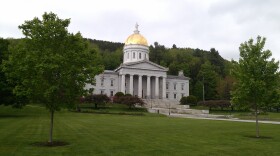It was a twist no one expected. Vermont two-term incumbent Governor Peter Shumlin was widely expected to trounce six challengers on election day. But the night dragged on, Tuesday turned to Wednesday, and still: no resolution. Now the race goes to the Legislature in January after the Republican challenger came remarkably close to winning.
The only question for most before Vermont’s polls closed on Tuesday was whether the incumbent governor would receive enough votes to push past Vermont’s 50 percent threshold to prevent the Legislature from making the final decision on the governor’s race.
The election results show that not only did Democrat Peter Shumlin fall below the 50 percent required for an outright win, Republican challenger Scott Milne trailed by one percentage point. The Associated Press shows Shumlin with 46 percent to Milne’s 45 percent. Libertarian Dan Feliciano received 4 percent. Just over 2,000 votes separate the Republican and Democrat.
Milne had scheduled a press conference Wednesday morning where it was expected he would concede. But he instead canceled and issued a statement:“What is clear is that the majority of Vermonters do not agree with the path that we are on. We are going to wait for the final numbers.”
Governor Shumlin held a mid-afternoon press conference Wednesday streamed on WPTZ Newschannel 5. “My job is to take the returns from this election, the message that I received loud and clear, and evaluate every single big decision that we’re making to make sure that we’re getting it right for Vermont. My job as governor is to listen and to learn from this election and that’s exactly what I will do. I didn’t sleep much last night and we’re not going to do much on the fly. The message is loud and clear. We need to work even harder to ensure that we’re making all the right decisions for Vermont.”
Seven Days Political Columnist Paul Heintz observed a governor who seemed rattled by the results. “For a politician that is often very confident, sometimes overconfident, he definitely appeared to be extraordinarily humbled by this. The governor did not share details about how he might approach health care reform differently for example. The other big issue that he raised was property taxes. He definitely said he was going to take another look at those issues. But it’s unclear to me precisely what he will do and whether he will change his agenda as a result of this.”
St. Michael’s College Political Scientist Bill Grover believes that the results don’t necessarily indicate that Milne ran a competitive campaign, but rather that Shumlin was going to have difficulty no matter who challenged him. “The governor was up against a Republican year. Here in Vermont in particular the roll out of the Vermont Health Exchange was very rocky and the financing of the single payer system he had to put that off. There’s a lot of economic uncertainty. A lot of uncertainty about property taxes. So I think those economic uncertainties coupled with a generally Republican year nationally worked against Governor Shumlin. I think he’s very lucky to squeeze out a roughly 2000 vote victory.”
Under Vermont's Constitution, if no candidate for governor, lieutenant governor or treasurer gets more than 50 percent, the election goes to the Legislature. Democrats are expected to maintain control of both houses, and the Legislature traditionally chooses the plurality winner in a gubernatorial election.







